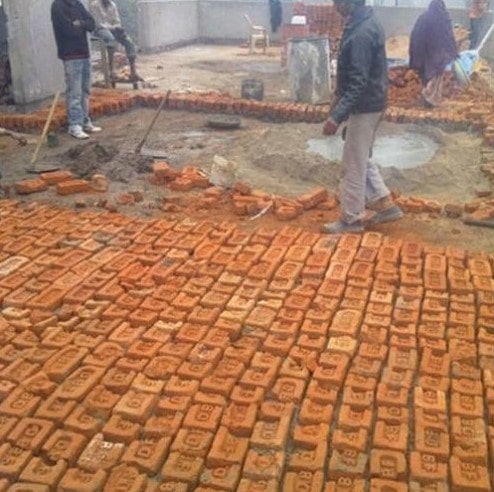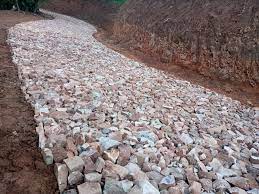What is soling?
Soling is the process of arranging or hand packing of rubble stones or bricks one adjacent to another, to provide a cushion and a stable strong subbase to the foundation and footing, before concreting work.
Why soling is done?
Rubble soling or boulder soling is done to enhance or too increase the bearing capacity of the soil, where hard strata is not available.
Generally basalt, granite, or locally available hard stones are used for soling purpose.
Types of soling
Based on the type of construction material used, these are of two types:
1. Brick Flat Soling
2. Rubble soling
1. Brick Flat Soling
The process of hand packing the bricks over the earth surface or on the sand bed is called as Brick flat soling.
In this type of soling, Bricks are arranged adjacent to each other to give a flat surface for concrete work. These are usually done in foundation and ground level.
Procedure of Brick flat soling :
1. The surface should be compacted by hand rammer and sprinkling water must be done.
2. Now hand pack the bricks on the surface so that they contact with each other. And the frog mark must be kept upwards.
3. Make the brick joints in the subsequent row of bricks in English bond pattern. Joints should not be in the same line. Use broken bricks (if any) at the edge of the area.
4. Fill the gaps or joints among the bricks with sand. The minimum FM of sand should be 0.50. Use a brush to properly fill the joints with sand. Don’t use water for flushing sand to fill the gaps.
5. Finally, check the finish surface is leveled both longitudinally and transversely.
2. Rubble soling
The process of hand packing the rubble stones over the earth surface or on the sand bed is called as rubble soling.
Generally basalt, granite, or locally available hard stones are used for soling purpose.
After the excavation for the footing or after murum filling in the plinth, the next sequential work we follow is, providing rubble soling over them
Procedure of Rubble soling :
1. Surface cleaning:
The surface over which the soling should be laid is cleared of all the loose materials, formworks, props, etc. If you find any leftover building raw materials over the base surface, that should be shifted beforehand to clear the area
2. Leveling and compaction :
You have to ensure that the murum ( construction soil ) filled in the plinth or excavated footing pit is properly compacted and leveled, using rammers and compactors to provide an even surface.
3. Laying stones :
Usually, the thickness of the rubble soling varies from 150mm ( 6 inches) to 250mm. (10 inches). The stones selected for the soling should be of uniform size with a maximum variation of ± 20mm. It should be elongated in shape with a broader base.
While laying them, the stones should be packed with minimum voids between the two. The elongated side is kept in the upright vertical position, with a broader base at the bottom.
First, you have to place the rubble soling, at all the four corners and at the center of the working area with the specified thickness. You have to check their top-level using a water tube or any other leveling instruments. By using lineout strings and tying or holding them from one to another, you can cover the leftover soling area easily, by maintaining the needed thickness and required top level.
4. Void filling :
After packing the stones, any voids left in between the soling should be filled with stone chips by inserting them in the gaps. Spreading the stone chips over the rubble soling using ghamela, without packing the voids should be avoided, as it does not slide in between the gaps.
5. Hammering :
After filling the voids, any protrusions of the stones should be knocked off by using hammers to maintain a leveled top surface. If you find some stones that are hard to break, then water the ground beneath the soling and press them inside the subsurface.
6. Compaction :
Use mechanical compactors or manual rammers to compact the soling. First, you have to spray sufficient water all over and then compaction work has to be carried out starting from one end and finishing at the other end, by covering all the surface area.
Specified murum is thinly spread all over the soling surface and watered again, so that the murum enters the narrow voids if left any, to provide a robust stabilized base for the concrete.
Final ramming is done and excess murum if left over the soling surface is then removed to provide a leveled base for the concrete.
Also read- What is gabion?| Types | Advantages | Applications | Disadvantages




